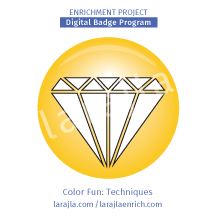 Don’t have time to explore different techniques to use on your coloring sheets? Here’s some to start you off!
Don’t have time to explore different techniques to use on your coloring sheets? Here’s some to start you off!
NOTE: The word “pencil” is used throughout this badge program, but may also reference crayons, markers, oil pastels, etc.
Steps
1. Pressure.
The more pressure you put on some pencils, the darker your color. Some will become damaged through pressure. To see the difference in shading, experiment with pencils and pressure.
2. Layers.
To make your color more vibrant, you can apply more layers of your color. On a sheet, color a square with one layer, then one with two layers and continue across the page. Be sure to note the number of layers on your sheet so you can see the difference.
3. Blending, dry.
You might decide to blend two or more colors. You can do the same pencil or different pencils. Dry blending is using a “dry” way to blend. this might include:
- Colorless blender
- Cotton swabs
- Finger
- Overlapping strokes
- Paper towel
- Stumps
- Tissue
Try one or more to see how each item gives the colors a different look. Continue experimenting with dry blending.
4. Blending, solvent.
Using a solvent makes your colors easier to blend. Start to experiment with these, then continue with your own ideas.
- Baby oil
- Blender marker
- Rubber cement thinner
- Rubbing alcohol
- Turpentine
NOTE: Be sure to follow any and all precautions with solvents.
5. Feathering.
Feathering is pulling the color away from the marks by blending. Experiment with feathering your color.
6. Hatching or linear.
Stroke your lines in a single direction. Applying varying pressure can make them darker or lighter. You can also put your lines closer together or further apart. Experiment with this technique.
7. Cross-hatching.
Cross-hatching involves stroking lines in a single direction (like the step above), then layering it with a set of lines at about 90°, making an X. You can use one or two colors. Try this technique.
8. Back and forth.
Most kids color this way. They just move their crayons back and forth to fill the area. You can keep the same angle or change it for different looks. You can try this technique, but you probably already have.
9. Scrumbling.
Coloring by making continuous circular marks is scrumbling. This is another technique you probably used as a kid. It’s a great way to fill an area with color quickly. Experiment with this technique.
10. Stippling.
Stippling is putting down small dots in an area. A “light” area has few dots with space between while a “heavy” area has a lot close together so it looks darker. Different sharpness on the point of your pencil can make different sized dots. You can also use more than one color. Try this technique.
11. Doodle.
Instead of coloring, you might like to doodle in the area. Check out the Enrichment Project badge program set “Zendoodle” for more information.
12. Rubbings.
Putting something behind your color area can add texture when you rub the color on it. Find something in your home with texture. You might want to try sandpaper, screening or wicker. Put your color sheet on top and rub to see the texture in the area. This technique is good for larger areas.
13. Adding highlights.
Using white pencils to add highlights can change the look of your piece. Experiment with using highlights.
14. Finishing fixative.
Depending on what you use to color, putting a fixative on things like chalk is important to keep it on the paper. Read about fixative and determine which mediums you use are likely to need it.
Supplements
SUPP_CF Tech_2in_12up_larajla
- Avery 2” round label — printable, 12 up
SUPP_CF Tech_Blends_larajla
- Experiment with blending two or more colors together
SUPP_CF Tech_Checklist_larajla
- Badge checklist
SUPP_CF Tech_Shades_larajla
- Create your own shade charts from 10-100%
Sites to Explore
- www.ebay.com/gds/My-Five-Favorite-Tools-for-Adult-Coloring-/10000000205660398/g.html
- www.art-is-fun.com/colored-pencil-instruction
- www.fabercastell.com/artandgraphic/adultcoloringbooks/coloringtechniques
- www.carrie-lewis.com/start-here
- www.carrie-lewis.com/start-here/getting-started-with-colored-pencil
- www.carrie-lewis.com/start-here/advanced-tips-tools-and-techniques
- www.youtube.com/watch?v=oMoBgr8UoJc
- www.youtube.com/watch?v=lYgue4gYmZY
- www.craftsy.com/blog/2015/07/colored-pencil-drawing-techniques
- www.craftsy.com/blog/2015/07/how-to-blend-colored-pencils
- emptyeasel.com/2012/07/16/howtoblendcoloredpencildrawingswithrubbingalcohol
- emptyeasel.com/2013/01/02/makingacolorwheelwithcoloredpencil
- www.ehow.com/how_4854851_useprismacolorpencils.html
- www.ehow.com/how_10025745_blendprismacolormarkers.html
- www.ehow.com/how_6168679_smoothlookprismacolorcoloredpencils.html
- keetonsonline.wordpress.com/2015/03/09/29-prismacolor-pencil-tips-techniques
- diycandy.com/2015/11/theultimateguidetofreecoloringpages
Get the infographic here > larajla blog post
Get the PDFs of the badge program / supplements here > Full badge PDFs